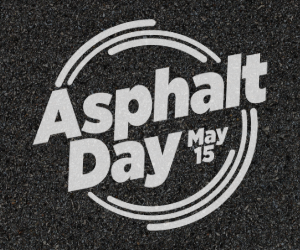
Road noise is a genuine concern today. Limited urban space results in developments being built closer to high-volume roadways, and the effects can be heard both day and night.
The type of road noise varies greatly depending on the speed and volume of the traffic, as well as the size of the vehicles. It can be broken down into a few main components: operation of the vehicle (engine noise), the interaction with the roadway surface, the type of tire and the location of the road.
Here we will be focusing on the techniques for reducing asphalt pavement noise as it relates to the interaction between vehicle tire and asphalt surface.
One of the quietest surfaces to drive on is a newly placed hot mix asphalt roadway. As the asphalt surface begins to wear, road noise will gradually start to increase. This noise is influenced by the properties of the road surface. An effective way to reduce road noise is to choose an appropriate asphalt-based mix design or treatment that incorporates both durability and noise dampening characteristics.
These mixes can be grouped into three categories: open-graded mixes, dense-graded mixes that have been optimized and have modifiers and fine-graded surfaces that include microsurfacing and ultra-thin bonded asphalt.
Open-graded asphalt mixtures
These mixes are designed to be water-permeable – they help to remove standing water from the road surface by allowing it to flow through the mix to the outer edges of the roadway. An added benefit of this porous design is good sound absorption. This is due to the compressed air from the tire being able to escape down through the mixture.
Open-graded asphalt mixes can incorporate polymer modified binder and/or fibers to add durability for long-term performance and prevent drain-down of the binder during construction. Some European countries have found that a highly porous (18-22 percent air void) double layer open-graded asphalt mix is best. The bottom layer contains larger aggregate while the top layer is a finer mix. This finer mix has less macrotexture, reducing contact forces which in turn would reduce noise. Noise reduction with these mixes has been measured at the 3-7 dB range.
These mixes work well for reducing noise when they are new, but over time the pores can start to clog, leading to a possible reduction in the noise dampening effect. The finer aggregate can wear quickly if not maintained and the reduction in noise can disappear. The best application for this type of mix is higher volume suburban roads with road speeds above 45 miles per hour. The higher speeds seem to keep the pores flushed. Due to the porous nature of these mixes, they are not as suitable for areas with freezing climates
Dense-graded asphalt mixtures
Reducing the aggregate size in the wearing surface will generally result in a quieter surface. These mixes could also incorporate crumb rubber and/or a polymer binder. This type of mixture gets its sound dampening qualities by having a reduced contact area (due to the smaller aggregate grading) as well as an increase in flexibility (due to the crumb rubber) allowing for air to escape at a lower pressure.
Instead of a 12.5-mm nominal maximum aggregate size (NMAS), these mixes often are produced to have an NMAS of 10-mm or lower. It has been noted that these types of mixes can reduce road noise by as much as 8 dB. The advantage of this type of mix compared to other noise-reducing mixes is its additional resistance to reflective cracking and rutting. The downside is the cost of the additional additives.
Fine-graded surface mixtures
Examples of these types of mixtures or surface treatments are microsurfacing and ultra-thin bonded asphalt surfaces. They can act as road preservation techniques and help reduce noise. These thin-surfaced, gap-graded mixes have less macrotexture which reduces contact areas between the tire and the road creating less noise. Reductions can be seen in the range of 2-5 dB.
Rather than the costly full-depth repaving of a road, these products can be applied over a well prepared existing surface as a much cheaper option. These mixes or treatments work best on medium- to high-volume roads in most climates. These surfaces can wear down (within 2 to 5 years) causing greater road noise near the end of their service life.
The types of mixes and treatments discussed above may help in the reduction of road noise if used and maintained properly. The biggest challenge will be in reducing possible added costs to encourage their use in a greater variety of areas.
Campbell is the general manager of General Liquids Canada in Nova Scotia.
Resources
www.wsdot.wa.gov/business/materialslab/quieterpavement
driveasphalt.org/noise














